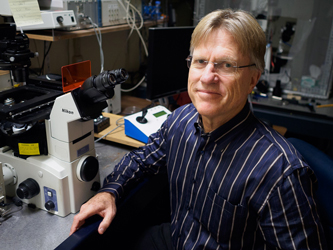Terry Machen

Professor Emeritus of Cell Biology, Development and Physiology
Research Interests
While I was still an active researcher, we investigated molecular and cellular mechanisms involved in ion and fluid transport across epithelial tissues, esp. those in the GI and respiratory tracts. The most recent work focussed on the interactions of airway epithelia and bacteria, with particular emphasis on the role of the cystic fibrosis transmembrane conductance regulator in preventing infections. Since 2020, my main efforts have been in teaching undergraduates in Bio1AL and MCB136.
Selected Publications
Pseudomonas aeruginosa triggers CFTR-mediated airway surface liquid secretion in swine trachea. [Luan X, Campanucci VA, Nair M, Yilmaz O, Belev G, Machen TE, Chapman LD, Ianowski JP. Proc. Nat. Acad. Sci., 111:12930-5, 2014] Noted in Nature as a “Research Highlight”: http://www.nature.com/nature/journal/v512/n7515/full/512350d.html
Paraoxonase 2 serves a proapopotic function in mouse and human cells in response to the Pseudomonas aeruginosa quorum-sensing molecule N-(3-Oxododecanoyl)-homoserine lactone. [Schwarzer C, Fu Z, Morita T, Whitt AG, Neely AM, Li C, Machen TE. J Biol Chem. 290(11):7247-5, 2015]
N-(3-oxo-acyl) homoserine lactone inhibits tumor growth independent of Bcl-2 proteins. [Zhao G, Neely AM, Schwarzer C, Lu H, Whitt AG, Stivers NS, Burlison JA, White C, Machen TE, Li C. Oncotarget. 7(5):5924-42, 2016]
Chemotaxis and binding of Pseudomonas aeruginosa to scratch-wounded human cystic fibrosis airway epithelial cells. [Schwarzer C, Fischer H, Machen TE. 2016. PLoS One. 11(3):e0150109, 2016]
Cystic fibrosis swine fail to secrete airway surface liquid in response to inhalation of pathogens [Luan X, Campanucci VA, Nair M, Yilmaz O, Belev G, Machen TE, Chapman D, Ianowski JP. Nat Commun. 8:786, 2017]
N-(3-oxo-acyl)-homoserine lactone induces apoptosis primarily through a mitochondrial pathway in fibroblasts [Neely AM, Zhao G, Schwarzer C, Stivers NS, Whitt AG, Meng S, Burlison JA, Machen TE, Li C. Cellular Microbiology, 20. doi: 10.1111/cmi, 2018.
Nebulized hypertonic saline triggers nervous system-mediated active liquid secretion in cystic fibrosis swine trachea. [Luan X, Tam JS, Belev G, Jagadeeshan S, Murray B, Hassan N, Machen TE, Chapman DE, Ianowski JP. Nature Sci. Rep. in press, 2019]
Photo credit: Mark Joseph Hanson of Mark Joseph Studio.
Last Updated 2025-02-04